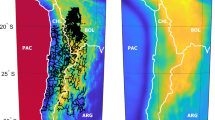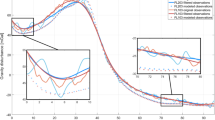Abstract
Due to the successful operation of dedicated satellite gravity missions, nowadays high-accuracy global gravity field models have become available. This triggers the challenge to optimally combine this long to medium wavelength gravity field information derived from space-borne data with high-resolution terrestrial gravity data. In this paper, the least squares collocation concept is revised with the attempt to consistently unify the combination procedure in such a way that the full information contained in both data sets is merged. For example, in local or regional geoid determination the remove-restore method is usually applied only partially taking into account the accuracy of the global model coefficients used for the long-wavelength reduction. The key advantage of the extended formulation is the fact that it automatically accounts for the error covariance of all data types involved. The applicability, feasibility and performance of the proposed method is investigated in the frame of numerical closed-loop simulations. The two main fields of application, i.e., the improvement of a global gravity field model by terrestrial gravity field data, and, vice versa, the support to a regional geoid solution by the incorporation of a global gravity field model, have been analyzed and assessed. Although applied under simplified conditions, it could be shown that the method works and is practically applicable.
Similar content being viewed by others
References
Albertella A., Sansó F. and Sneeuw N., 1999. Band-limited functions on a bounded spherical domain: the Slepian problem on the sphere. J. Geodesy, 73, 436–447.
Bouman J., 2000. Quality assessment of satellite-based global gravity fields models. Publications on Geodesy, 48, Netherlands Geodetic Commission, Delft, The Netherlands.
Catastini G., Cesare S., De Sanctis S., Dumontel M., Parisch M. and Sechi G., 2007. Predictions of the GOCE in-flight performances with the end-to-end system simulator. In: Fletcher K. (Ed), The 3rd International GOCE User Workshop, ESA SP-627, ESA Publications Division, Noordwijk, The Netherlands, ISBN 92-9092-938-3, 9–16.
Colombo O.L., 1981. Numerical Methods for Harmonic Analysis on the Sphere. Report No. 310, Department of Geodetic Science, The Ohio State University, Columbus, Ohio.
Ditmar P., Kusche J. and Klees R., 2003. Computation of spherical harmonic coefficients from gravity gradiometry data to be acquired by the GOCE satellite: Regularization issues. J. Geodesy, 77, 465–477.
ESA, 1999. Gravity Field and Steady-State Ocean Circulation Mission, ESA SP-1233(1). Report for Mission Selection of the Four Candidate Earth Explorer Missions, ESA Publications Division, ESA, Noordwijk, ISBN 9290925280.
Förste C., Flechtner F., Schmidt R., König R., Meyer U., Stubenvoll R., Rothacher M., Barthelmes F., Neumayer H., Biancale R., Bruinsma S., Lemoine J.-M. and Loyer S., 2007. Global mean gravity field models from combination of satellite mission and altimetry/gravimetry surface data. In: Fletcher K. (Ed), The 3rd International GOCE User Workshop, ESA SP-627, ESA Publications Division, Noordwijk, The Netherlands, ISBN 92-9092-938-3, 163–168.
Förste C., Flechtner F., Schmidt R., Stubenvoll R., Rothacher M., Kusche J., Neumayer K.H., Biancale R., Lemoine J.-M., Barthelmes F., Bruinsma S., König R. and Meyer U., 2008. EIGEN-GL05C — A new global combined high-resolution GRACE-based gravity field model of the GFZ-GRGS cooperation. Geophysical Research Abstracts, 10, EGU2008-A-03426 (http://edoc.gfz-potsdam.de/gfz/get/11298/0/8018bf0a94cc72f1708dab50f8f88d37 /foerste_EGU2008-A-03426.pdf).
Gruber T., 2001. High resolution gravity field modeling with full variance-covariance matrices. J. Geodesy, 75, 505–514.
JPL, 1998. GRACE: Gravity Recovery and Climate Experiment: Science and Mission Requirements Document. Revision A. JPLD-15928, NASA’s Earth System Science Pathfinder Program, Jet Propulsion Laboratory, Pasadena, CA.
Kaula W.M., 1966. Theory of Satellite Geodesy: Applications of Satellites to Geodesy. Dover Publications, Mineola, New York.
Knudsen P., 1987. Estimation and modelling of the local empirical covariance function using gravity and satellite altimeter data. Bulletin Géodésique, 61, 145–160.
Krarup T., 1969. A Contribution to the Mathematical Foundation of Physical Geodesy. Geodætisk Instituts, Meddelelse, 44, Copenhagen, Denmark.
Lemoine F.G., Kenyon S.C., Factor J.K., Trimmer R.G., Pavlis N.K., Chinn D.S., Cox C.M., Klosko S.M., Luthcke S.B., Torrence M.H., Wang Y.M., Williamson R.G., Pavlis E.C., Rapp R.H. and Olson T.R., 1998. The Development of the Joint NASA GSFC and the National Imagery and Mapping Agency (NIMA) Geopotential Model EGM96. NASA Technical Report TP-1998-206861, National Aeronautics and Space Administration, Goddard Space Flight Center, Greenbelt, Maryland, USA.
Maggi A., Migliaccio F., Reguzzoni M. and Tselfes N., 2007. Combination of ground gravimetry and GOCE data for local geoid determination: a simulation study. Proceedings of the 1st International Symposium of IGFS. Harita Dergisi, Special Issue 18. General Command of Mapping, Ankara, Turkey, 1–6, ISSN: 1300-5790.
Metzler B. and Pail R., 2005. GOCE data processing: the spherical cap regularization approach. Stud. Geophys. Geod., 49, 441–462.
Moritz H., 1972. Advanced Least-Squares Methods. Report No. 175, Department of Geodetic Science, The Ohio State University, Columbus, Ohio.
Moritz H., 1978. Least-squares collocation. Rev. Geophys. Space Phys., 16, 421–430.
Moritz H., 1989. Advanced Physical Geodesy. Herbert Wichmann Verlag, Karlsruhe, Germany.
Pail R., Plank G. and Schuh W.-D., 2001. Spatially restricted data distributions on the sphere: the method of orthonormalized functions and applications. J. Geodesy, 75, 44–56.
Pavlis N.K., Holmes S.A., Kenyon S.C. and Factor J.K., 2008. An Earth Gravitational Model to Degree 2160: EGM2008. Geophysical Research Abstracts, 10, 2-2-2008. Full version released by National Geospatial-Intelligence Agency, Bethesda, MD, (http://www.dgfi.badw.de/typo3_mt/fileadmin/2kolloquium_muc/2008-10-08/Bosch/EGM2008.pdf).
Pertusini L., Reguzzoni M. and Sansó F., 2010. Analysis of the covariance structure of the GOCE space-wise solution with possible applications. In: Mertikas S.P. (Ed.), Gravity, Geoid and Earth Observation: IAG Commission 2: Gravity Field, Chania, Crete, Greece, 23–27 June 2008. International Association of Geodesy Symposia, 135, Springer-Verlag, Berlin and Heidelberg, ISBN: 978-3642106330.
Rapp R.H., 1989. Combination of satellite, altimetric, and terrestrial gravity data. In: Bhattacharji S., Friedman G.M., Neugebauer H.J. and Seilacher A. (Eds.), Theory of Satellite Geodesy and Gravity Field Determination. Lecture Notes in Earth Sciences, 25, Springer-Verlag, Berlin and Heidelber, 261–284, ISBN: 978-3540515289.
Rapp R.H. and Pavlis N.K., 1990. The development and analysis of geopotential coefficient models to spherical harmonic degree 360. J. Geophys. Res., 95(B13), 21885–21911.
Reigber Ch., Schwintzer P. and Lühr H., 1999. CHAMP geopotential mission. Bollettino di Geofisica Teorica e Applicata, 40, 285–289.
Rummel R., Gruber T. and Koop R., 2004. High level processing facility for GOCE: Products and processing strategy. In: Lacoste H. (Ed.), Proceedings of the Second International GOCE User Workshop, The Geoid and Oceanography. ESA SP-569, ESA Publications Division, Noordwijk, The Netherlands, ISBN: 92-9092-880-8.
Sacerdote F. and Sansó F., 2010. Least squares, Galerkin and boundary value problems. In: Mertikas S.P. (Ed.), Gravity, Geoid and Earth Observation: IAG Commission 2: Gravity Field, Chania, Crete, Greece, 23–27 June 2008. International Association of Geodesy Symposia, 135, Springer-Verlag, Berlin and Heidelberg, ISBN: 978-3642106330.
Schwartz T., 1979. Geodetic improperly posed problems and their regularization. Bollettino di Geodesia e Scienze Affini, 38, 389–416.
Sneeuw N. and van Gelderen M., 1997. The polar gap. In: Sansó F. and Rummel R. (Eds.), Geodetic Boundary Value Problems in View of the One Centimeter Geoid. Lecture Notes in Earth Sciences, 65, Springer-Verlag, Berlin and Heidelberg, 559–568, ISBN: 978-3540626367.
Tikhonov A.N. and Arsenin V.Y., 1977. Solutions of Ill-Posed Problems. JohnWilney and Sons, New York.
Tscherning C.C., 1974. A FORTRAN IV Program for the Determination of the Anomalous Potential Using Stepwise Least Squares Collocation. Report No. 212, Department of Geodetic Science, The Ohio State University, Columbus, Ohio.
Tscherning C.C., 2001. Covering the GOCE mission polar gaps using gradients and ground gravity. Proceedings of the International GOCE User Workshop. ESTEC ESA WPP-188, Noordwijk, The Netherlands, 105–110.
Tscherning C.C. and Rapp R., 1974. Closed Covariance Expressions for Gravity Anomalies, Geoid Undulations, and Deflections of the Vertical Implied by Anomaly Degree Variance Models. Report No. 208, Department of Geodetic Science, The Ohio State University, Columbus, Ohio.
Author information
Authors and Affiliations
Corresponding author
Rights and permissions
About this article
Cite this article
Pail, R., Reguzzoni, M., Sansó, F. et al. On the combination of global and local data in collocation theory. Stud Geophys Geod 54, 195–218 (2010). https://doi.org/10.1007/s11200-010-0010-1
Received:
Revised:
Accepted:
Published:
Issue Date:
DOI: https://doi.org/10.1007/s11200-010-0010-1




